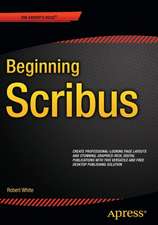Surfaces in Range Image Understanding: Springer Series in Perception Engineering
Autor Paul J. Beslen Limba Engleză Paperback – oct 2011
Preț: 334.71 lei
Preț vechi: 418.38 lei
-20% Nou
Puncte Express: 502
Preț estimativ în valută:
64.05€ • 66.87$ • 53.01£
64.05€ • 66.87$ • 53.01£
Carte tipărită la comandă
Livrare economică 04-18 aprilie
Preluare comenzi: 021 569.72.76
Specificații
ISBN-13: 9781461283966
ISBN-10: 1461283965
Pagini: 360
Ilustrații: XV, 339 p.
Dimensiuni: 152 x 229 x 19 mm
Greutate: 0.48 kg
Ediția:Softcover reprint of the original 1st ed. 1988
Editura: Springer
Colecția Springer
Seria Springer Series in Perception Engineering
Locul publicării:New York, NY, United States
ISBN-10: 1461283965
Pagini: 360
Ilustrații: XV, 339 p.
Dimensiuni: 152 x 229 x 19 mm
Greutate: 0.48 kg
Ediția:Softcover reprint of the original 1st ed. 1988
Editura: Springer
Colecția Springer
Seria Springer Series in Perception Engineering
Locul publicării:New York, NY, United States
Public țintă
ResearchCuprins
1 Introduction.- 1.1 Perception, Surfaces, and Range Images.- 1.2 Low-Level vs. High-Level Processing.- 1.3 Data-Driven Range Image Analysis.- 1.4 Qualitative Algorithm Description.- 1.5 Overview.- 1.6 Literature Review.- 2 Object Recognition and Segmentation.- 2.1 Three-Dimensional Object Recognition.- 2.2 Mathematical Recognition Problem.- 2.3 Recognition System Components.- 2.4 Capabilities of an Ideal System.- 2.5 Segmentation into Surface Primitives.- 2.6 Mathematical Segmentation Problem.- 2.7 Segmentation Errors.- 2.8 Range Image Segmentation and Recognition.- 2.9 Summary.- 3 Surface Curvature Characteristics.- 3.1 Visible Invariance.- 3.2 Differential Geometry Review.- 3.3 Surface Curvature.- 3.4 Graph Surface Curvature from Derivatives.- 3.5 Estimating Derivatives of Digital Surfaces.- 3.6 Other Surface Characteristics.- 3.7 Summary.- 3.8 Experimental Surface Characterization Results.- 4 From Surface Labels to Surface Primitives.- 4.1 Problems with HK-Sign Maps.- 4.2 Segmentation Algorithm Philosophy.- 4.3 Segmentation Algorithm Description.- 4.4 Approximating Function Selection.- 4.5 Noise Estimation and Threshold Specification.- 4.6 Seed Region Extraction.- 4.7 Iterative Variable Order Surface Fitting.- 4.8 Region Growing.- 4.9 Hemisphere Surface Example.- 4.10 Termination Criteria and Convergence.- 4.11 Surface Acceptance and Rejection Decisions.- 4.12 Summary.- 5 Description Combination and Region Merging.- 5.1 Region Description Combination.- 5.2 Region Adjacency Graphs.- 5.3 Region Merging.- 5.4 Final Region Segmentation Output.- 6 Region Edges.- 6.1 Edge Detection and Dimensionality.- 6.2 Edge Algorithm Description.- 6.3 Edge Definition.- 6.4 Edge Characterization.- 6.5 Approximating Function Selection.- 6.6 Error Tolerance Specification.- 6.7 Seed Interval Extraction.- 6.8 Iterative Variable Order Edge Fitting.- 6.9 Edge Interval Growing.- 6.10 Termination Criteria.- 6.11 Edge Interval Acceptance.- 6.12 Interval Merging and Interval Connections.- 6.13 Summary.- 7 Experimental Results.- 7.1 Real Range Images.- 7.2 Synthetic Range Images.- 7.3 Intensity Images.- 7.4 Segmentation Results.- 8 Conclusions and Future Directions.- 8.1 Range Image Understanding.- 8.2 Algorithm Properties.- 8.3 Final Data Description.- 8.4 Future Directions.- A Surface Curvature Invariance Theorems.- B Discrete Intrinsic Properties.- C Least Squares Surface Fitting.- D Equal Angle Increment Sampling.- E A Metric Space of Image Regions.- F Software Implementation.- G Iterative Region Growing Algorithm.- References.































